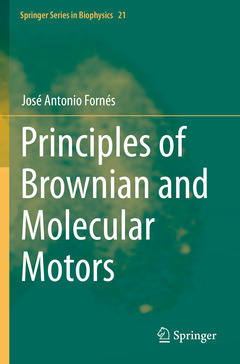1 Brownian Ratchets and Molecular Motors 3
1.1 The force-generation 3
1.1.1 Maximum Driving Force 3
1.1.2 Stall Force 5
1.2 Smoluchowski-Feynman’s ratchet as a heat engine 6
1.2.1 Parrondo Criticism 7
1.3 Ratchet Efficiency 7
1.4 Ratchet Coherency 9
1.5 First Passage Time 9
1.6 Power Stroke 10
2 The Fokker-Planck equation 17
2.1 The Methods 17
2.2 The Fokker-Planck Equation 18
2.3 Discretization of the Fokker-Planck equation 19
2.3.1 Forward Time Central Space (FTCS) Method 19
2.3.2 Crank-Nicholson Method 20
2.3.3 Stability Analysis 21
2.4 Program 2.1, F-P Equation, Matlab code 25
3 Biased Brownian Motion 27
3.0.1 Parametrization of the Langevin Equation 27
3.0.2 Numerical Simulations 28
3.0.3 Building the Fokker-Plank’s matrices 30
3.0.4 Dichotomous Markov noise 33
3.0.5 Fluctuating Potential, or “Flashing” Ratchet 36
3.0.6 Fluctuating Force, or “Rocking” Ratchet 41
3.1 Programs 46
3.1.1 Program 3.1, Euler Equation, Matlab code 46
3.1.2 Program 3.2, F-P Equation, Matlab code 46
3.1.3 Program 3.3, Dichotomous Noise, Matlab code 48
3.1.4 Program 3.4, Flashing Ratchet, Matlab code
3.1.5 Program 3.5, Rocking Ratchet, Matlab code
4 The Smoluchowski model 49
4.1 Diffusion 52
4.2 Chemical kinetics 54
4.2.1 Absolute Reaction Rate Theory 55
4.3 A mechanochemical model 58
4.3.1 Numerical computation of mechanochemical coupling 59
4.4 Program 4.1, Matlab code 62
5 Rotation of a dipole. 67
5.1 Introduction 67
5.2 Langevin Equation for the rotor 68
5.3 Dipole in a Ratchet Electrical Potential 70
5.4 Program 5.1, Matlab code 80
6 Ratchet dimer Brownian motor with Hydrodynamic interactions 84
6.1 Introduction 84
6.2 The Model 85
6.3 Hydrodynamic interactions 88
6.4 Brownian dynamics with hydrodynamic interactions 90
6.4.1 Efficiency 91
6.5 Program 6.1, Fortran code 100
7 Fluctuations of the proton electromotive force across inner mitochondrial membrane 115
7.1 Introduction 115
7.2 Theory 116
7.3 Fluctuations of th Proton-Electromotive 116
7.4 Parameter Definitions 118
7.5 Calculation of Buffer Equivalent Electrical Capacitance 118
7.6 Calculation of IMM Electrical Resistance Rm 119
7.7 Relaxation Times of the Electrical and Buffer Reservoirs 119
7.8 Program 7.1, Fluctuations of the PMF, Matlab code 126
8 Quantum Ratchets 128
8.1 The Quantum Langevin Equation 128
8.1.1 The Correlation Quantum Function 131
8.1.2 The Quantum Overdamped Langevin Equation with colored noise 132
8.1.3 The Quantum Underdamped Langevin Equation 136
8.1.4 The Ranges 138
8.2 Programs
8.2.1 Program 8.1a, Moderate Damping, Matlab code
8.2.2 Program 8.1b, Complete Langevin Equation, Matlab code
Appendices 145
A 01 155
A.1 Master Equation 155
A.1.1 Transition Rate 155
A.1.2 Probability Flux 155
A.1.3 Master Equation 155
A.1.4 Poisson’s Process 156
A.1.5 Detailed balance 156
B 01 158
B.1 Information Flow 158
C 01 163
C.1 Endoreversible Thermodynamics 163
D 01 167
D.1 First Passage Phenomena 167
D.1.1 Properties of First Passage Time 167
D.1.2 Application to Chemical Kinetics 168
A 02 171
A.1 Stochastic Dynamics 171
A.1.1 White Noise and Wiener Process 171
A.1.2 Spectral Intensity 171
A.1.3 Properties of Wiener’s Process 172
A.1.4 Stochastic Process Derivative 173
A.1.5 SDE with Aditive Noise 173
A.1.6 SDE with Multiplicative Noise 174
A.1.7 Itô’s and Stratonovich’s Calculus 174
B 02 179
B.1 Stochastic Energetics 179
B.1.1 Sekimoto View 180
B.1.2 Entropy Production 181
B.1.3 Stochastic Energetics - Useful relations 181
A 03 184
A.1 Solution of Equation 184
A.2 Damped oscillations 184
B 188
B.1 Electrical and mechanical systems analogies 188
C 190
C.1 The fluctuation-dissipation theorem 190
D 193
D.1 Integral Algorithm for Colored Noise Simulation 193




